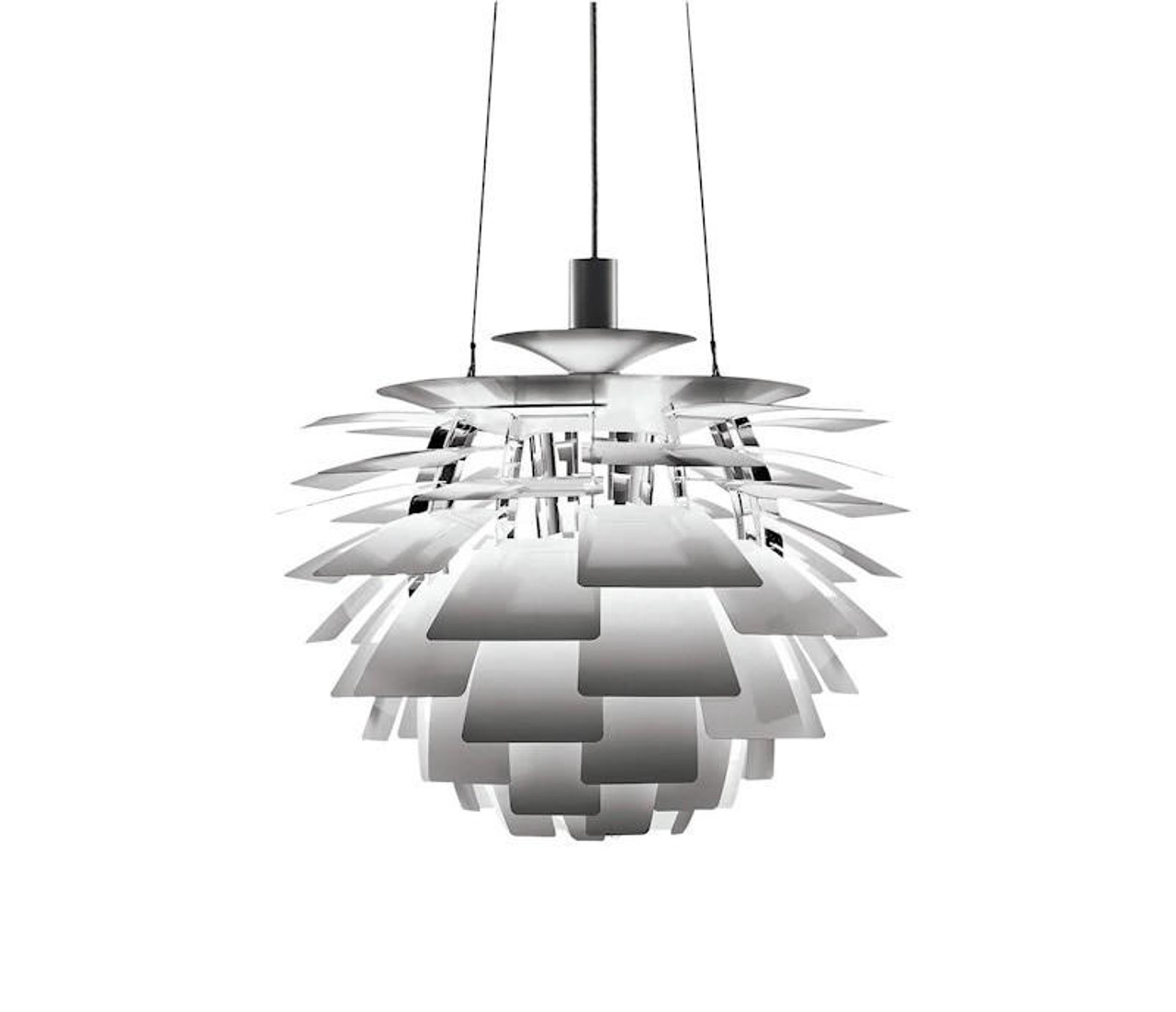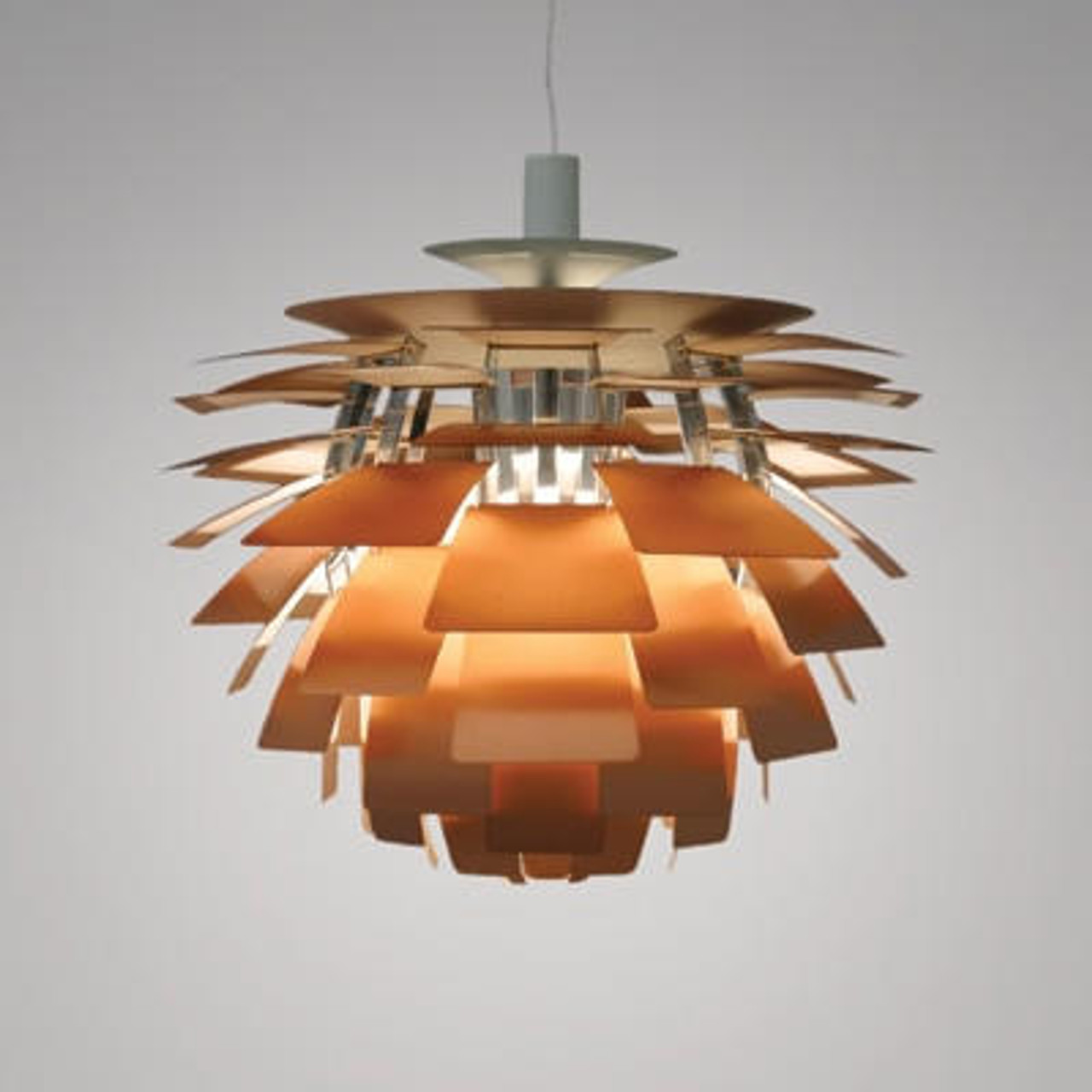The History and Legacy of the Louis Poulsen Artichoke Pendant
Posted by Bert Ron-Harding: Architectural Technologist on Oct 15, 2024
In the world of architecture and design, every piece of furniture, every light fixture, and every material has a story to tell—a narrative that spans time, culture, and the evolving needs of those who inhabit our built environments. One such design object, which has transcended its function to become a beacon of modernism and artistic expression, is the Louis Poulsen Artichoke Pendant.
Born from the ingenuity of mid-century design, the Louis Poulsen Artichoke Pendant is a prime example of how form and function, when married in harmony, create objects that feel as fresh today as they did when they first debuted. Its unique, sculptural shape and intricate construction evoke the layers of an artichoke, a natural form that is both organic and geometric. But to truly appreciate the Louis Poulsen Artichoke Pendant, one must first understand its origins—where it came from, how it has evolved, and why it remains an enduring symbol of thoughtful design.
The Vision of Poul Henningsen: Light as an Art Form
To tell the story of the Louis Poulsen Artichoke Pendant, we must begin with Poul Henningsen, the Danish designer responsible for its creation. Henningsen wasn’t just a designer in the traditional sense; he was a lighting visionary. Born in 1894, Henningsen’s fascination with light began early in life, and it was a fascination that transcended the simple need to illuminate a room. For him, light was an art form—a medium through which moods could be shaped, environments transformed, and people connected to their spaces in profound ways.
In the mid-20th century, Henningsen began collaborating with Louis Poulsen, a Danish lighting manufacturer with a shared commitment to creating innovative lighting solutions. Together, they set out to rethink the very nature of how light interacts with objects, surfaces, and the human experience.
Henningsen’s philosophy revolved around the interplay of direct and indirect lighting, aiming to soften the harshness of electric light and mimic the warm, diffused glow of natural sunlight. This focus on reducing glare and creating a pleasant ambiance would later become central to his designs and manifest most spectacularly in the creation of the Louis Poulsen Artichoke Pendant.
The Birth of an Icon: The Louis Poulsen Artichoke Pendant
In 1958, Henningsen was commissioned to design a fixture for the Langelinie Pavilion, a prestigious restaurant on the waterfront in Copenhagen. The result was the Louis Poulsen Artichoke Pendant, a fixture that not only satisfied the restaurant’s need for elegant, glare-free lighting but also became a design icon in its own right.
The Artichoke Pendant consists of 72 copper "leaves" arranged in 12 layers, which carefully shield the light source while reflecting and diffusing light to create a soft, even glow. Its multi-layered construction allows light to emerge from multiple angles, creating a sense of warmth and depth that is as visually stunning as it is functional. Henningsen’s meticulous attention to detail ensured that the light was emitted without any harsh glare, regardless of the angle from which it was viewed. This feature became a defining characteristic of the Louis Poulsen Artichoke Pendant, setting it apart from other contemporary lighting designs.
But what truly sets the Louis Poulsen Artichoke Pendant apart is its sculptural form. Henningsen took inspiration from nature, borrowing the symmetrical, layered pattern of an artichoke. This blend of organic inspiration and geometric precision became a hallmark of Scandinavian design, embodying the movement’s commitment to simplicity, functionality, and beauty.
Mid-Century Modernism Meets Timeless Design
The mid-century modern era, characterized by clean lines, open spaces, and an emphasis on form and function, provided the perfect backdrop for the Louis Poulsen Artichoke Pendant to make its debut. Its minimalist yet intricate design resonated with the architectural movements of the time, where designers like Le Corbusier, Eero Saarinen, and Mies van der Rohe were breaking boundaries between art and architecture.
The pendant’s ability to balance complex geometry with a minimalist aesthetic made it a favorite among architects and interior designers alike. It was not just a light fixture—it was a statement piece. The Louis Poulsen Artichoke Pendant became synonymous with sophisticated, modern spaces, whether it was hung in a chic living room, a high-end restaurant, or an avant-garde gallery.
Legacy and Enduring Appeal
Over the years, the Louis Poulsen Artichoke Pendant has transcended trends and time periods, continuing to captivate generations of designers and homeowners. Its appeal lies in its ability to adapt to various design contexts while maintaining its original integrity. Whether placed in a modernist home, a minimalist office, or even a classical interior, the Artichoke Pendant adds an element of refinement and complexity to any space.
One reason for its enduring appeal is its craftsmanship. Each Louis Poulsen Artichoke Pendant is meticulously handcrafted by skilled artisans who understand the precision required to assemble the intricate layers. The materials used—ranging from copper to steel to brushed aluminum—ensure that the pendant not only looks stunning but also stands the test of time. This commitment to quality is part of the legacy that Louis Poulsen has cultivated as a brand, and it’s a legacy that Henningsen himself helped to shape.
Another reason the Louis Poulsen Artichoke Pendant remains relevant today is its versatility. Available in various sizes and finishes, the pendant can be customized to fit any space, large or small. This flexibility has allowed it to remain a popular choice for both residential and commercial projects, from luxury hotels and boutiques to private homes and offices.
Beyond Light: The Symbolism of the Louis Poulsen Artichoke Pendant
In the world of design, certain objects take on a life of their own. The Louis Poulsen Artichoke Pendant is one such object, a symbol of innovation, elegance, and the seamless blending of form and function. But beyond its practical and aesthetic appeal, the Artichoke Pendant represents something more profound: the idea that good design has the power to transform spaces and, in turn, elevate the human experience within them.
For Henningsen, the Louis Poulsen Artichoke Pendant wasn’t just about creating a beautiful object. It was about creating an experience—a way for people to interact with light in a more meaningful and nuanced way. In this sense, the pendant transcends its role as a mere lighting fixture and becomes a piece of art, one that speaks to the very essence of what design is all about: improving the way we live.
Conclusion: The Future of the Louis Poulsen Artichoke Pendant
As we look to the future, the Louis Poulsen Artichoke Pendant remains as relevant as ever. Its timeless design continues to inspire new generations of architects, interior designers, and design enthusiasts, proving that true innovation never goes out of style. Whether it’s gracing the ceilings of modern homes or being reimagined in contemporary projects, the Artichoke Pendant is a testament to the enduring power of thoughtful, well-executed design.
The legacy of the Louis Poulsen Artichoke Pendant extends beyond its physical form. It serves as a reminder that great design is not just about solving a functional problem—it’s about creating beauty, fostering connection, and elevating the human experience. In this sense, the Louis Poulsen Artichoke Pendant is not just a lighting fixture; it’s a timeless masterpiece, a symbol of the very best that design has to offer. And as long as there are spaces in need of illumination, the Artichoke Pendant will continue to light the way.




